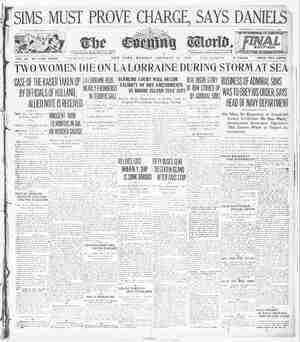The Nonpartisan Leader Newspaper, January 19, 1920, Page 3
You have reached the hourly page view limit. Unlock higher limit to our entire archive!
Subscribers enjoy higher page view limit, downloads, and exclusive features.
Y In the inferest of a square deal for the farmers ) ] RGN B A B o D U B S S5 SR A \ Nonpartisan Teader Official Magazine of the National Nonpartisan League VOL 10, NO. 3 A magazine that dares to print the truth ST. PAUL, MINNESOTA, JANUARY 19, 1920 WHOLE NUMBER 226 “Mexican Dollars” and the H. C. of L. ’ - Why College Professors Decided to Organize a Labor Union BY E. B. FUSSELL the line” into Mexico it is not any difference in climate or the dress or color of the inhabitants that attracts attention—there are just about as many Mexi- cans directly north of the “line” as directly south of it and the sun is -about as hot one place The thing that the tourist is apt to as the other. notice first is that every article offered for sale in the store windows bears two ‘prices. If it is a fancy sombrero, or Mexican hat,-the price probably is marked “§5 U. S.; $10 Mexican.” Whatever the object may be—an Indian rug, an opaly a chicken or a box of cigars—there are two price marks. The first mark is the price in American money. The second, just twice as high, is the price in Mex- ican money. It is not through any courtesy to the United States that the price is made lower in our own money; it is because a dollar bearing the words “United States of America” on one side and “E pluribus unum” on the other is worth twice as much as a Mexican dollar. Recently there appeared before League members of the North Dakota legislature, meeting in ‘spe- cial session, a member of one of the newest labor unions formed in the United States. He was A. D. Weeks, dean and professor of education at the North Dakota Agricultural college and representa- tive of the organization at the college, which com- prises 85 per cent of the instructors and professors and is affiliated with the American Federation of Labor. He was explaining the widespread dissatis- HEN an American goes “across . and What They Are Doing faction, among wage-earners and salaried men, throughout the country over present wages and salaries, although they are higher than they ever have been before. “The fact is that today we are being paid in money that' has only half the purchasing power of five years ago,” he said. “It is just as if we were being paid in Mexican dollars.” Another representative of the organized teachers, John M. Gillette, professor of sociology of the Uni- versity of North Dakota, where the instructors are also organized, presented a series of charts that showed graphically just what Doctor Weeks meant. COST OF LIVING INCREASES FROM 71 TO 100 PER CENT IN FIVE YEARS One of these charts showed the cost of living increases in retail prices, according to investiga- tions of the Babson Statistical Institute, comparing prices in July, 1914, with those of July; 1919. This chart showed an increase in food prices of 85 per cent; shelter, 28 per cent; clothing, 100 per cent; fuel, heat, etc., 57 per cent; sundries, 63 per cent. The average increase in prices shown by all these items was 71 per cent. This, however, is the lowest estimate that has been made. According to the. United States de- partment of labor, investigating wholesale prices throughout the United States, the increase in the same period was not 71 per cent, but 96 per cent, while other investigators have found the average increase to be above 100 per cent. Doctor Gillette presented another chart. It showed the average salaries being paid for different classes of teachers at the university, and the actual purchasing power of the “depreciated dollars,” as follows: Grades Av. salaries Purchasing power Instructor ~........ $1,474 $ 842 Assistant professor. 1,885 1,080 Associate professor. 2,300 1,314 Professor ......... 2,705 1,546 “What we are asking,” said Doctor Gillette, speaking in behalf of the university teachers, “is a 25 per cent increase in salaries. That will meet just one-third of the deficit that we are facing today because of the reduced purchasing power of money.” At the North Dakota Agricultural college even lower salary scales prevail than at the university. This is a common comparison of the salaries paid to different classes: 5 Grades University College Deans .. 50 e iese ceieee...$3,660 $2,877 Professors ......... seias oo 1 2500D 2,362 Assistant professors ...... 1,885 1,863 Instructors ......... e 1,474 1,436 Salaries at the institutions in North Dakota are not - strikingly lower than at other institutions throughout the United States, when the compar- ative size of the colleges is considered. But in- structors and professors in North Dakota were quicker than those in other parts of the Union to see the benefits of organization. They had before them the example of the organized farmers, who almost overnight had been able to take charge of their state government and bring about reforms that meant millions to them. And as early as last (Continued on page 13) HAVING HIS (MIS)FORTUNE TOLD AND YoU ARE |= GOING To GET T RIGHT IN — THE NECK = = @ \ PAGE THREE ~—Drawn expressly for the Leadér\by W. C. Morris.







